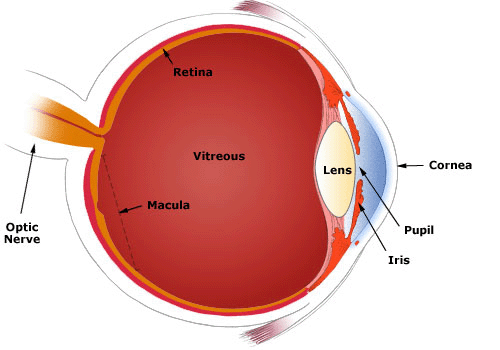
Before you can fully understand how eye surgery in California can improve your vision, it is important to understand how the eye works.
Eyesight is made possible through an amazing interaction of the eye's components. Here's how it happens:
This is how normal eyesight works. Many of us have slight or not-so-slight defects in our vision, so that we don't see that new car clearly unless we correct our vision with glasses or contact lenses. For many years those were our only choices, but lasers and lens implants have opened a new world for vision correction.
Nearsightedness
When the cornea is too steep, it bends the light rays too much and they come to a focus in front of the retina. A nearsighted person can see well up close, but distant objects look blurry.
Dr. Feldman's VISX laser can remove tiny amounts of tissue near the center of the cornea so that the steepness is flattened a little. Then the light rays will focus exactly where they should, on the retina, and we'll see clearly.
Farsightedness
When the cornea is too flat, it bends the light rays too little, and they come to a focus behind the retina. A farsighted person can see well at a distance, but nearby objects look blurry.
The VISX laser can remove tiny areas of tissue near the edges of the cornea, so that the flatness is made a little steeper. Then the light rays will be bent more and will focus on the retina, giving us clear vision.
Astigmatism
The cornea is meant to be round. In some people, it has an oval shape, which means it has two curves: a steeper one and a flatter one. This creates an uneven image, where some light rays may focus on the retina and others don't.
A laser vision correction treatment can remove tiny pieces of corneal tissue to make the cornea round “ evenly curved like a basketball “ and this will improve clarity of vision.
As we age, the lens becomes gradually stiffer, and the tiny muscles attached to it, become weaker. To allow us to see equally well close up and at a distance, the lens must accommodate itself, becoming flatter for distance vision and more convex for near vision. When it loses this ability to increase its convexity, we lose our ability to see well up close. A person over about 40 or 45 will inevitably get presbyopia, regardless of previous vision, sex, race, lifestyle, nutrition or any other variable. Then out come the famous reading glasses.
Presbyopia is age-related farsightedness, not caused by the cornea being too flat, but by the lens being unable to become curved enough. Therefore a standard laser vision correction procedure can't treat it. Instead, monovision laser vision correction, contact lenses or intraocular lenses are used.
You can read more about these options by using these links.
As we age, not only does the lens become stiffer, it can also become cloudy, causing dimness in our vision.
The lens mostly consists of water and various proteins. Over time, the proteins can start clumping together, creating a small area of opacity in the otherwise transparent lens. Now when the light rays enter the eye, they pass through the cornea, but some of them are blocked by the cloudy area, and don't reach the retina. Thus we have missing information in our eyesight.
If no treatment is done, this opaque area, the cataract, will slowly expand until the person loses all vision and becomes blind. So far, there is no way to reverse the cataract growth. The only successful treatment is to replace the natural lens with an implantable lens.
Besides aging, there are some other risk factors for cataracts, such as diabetes and certain medications.
To learn more about cataracts and the ways we can treat them, please use these links.
If you'd like to schedule a complimentary LASIK/PRK consultation or a cataract eye exam with Dr. Feldman, contact us today. Dr. Feldman will take the time to listen to you and answer your eye surgery questions. Our office is friendly and comfortable, and we're dedicated to improving your vision. Give us a call today.
ClearView Eye and Laser Medical Center provides eye surgery procedures in the San Diego, California area. We offer this web page as general information. This information should not be considered formal medical advice. Please contact us today for formal advice during a complimentary consultation in San Diego.
Change Your Vision,
Change your Life!
Copyright © 2024 Clearview Eye and Laser Medical Center in San Diego, California. All rights reserved.
LASIK is a medical procedure with risks involved and isn't right for everyone. Individual results may vary. Talk to your eye doctor and consider both the risks and benefits before having the procedure. Additional information can be found at our website or at fda.gov. the material contained on this site is for informational purposes only and is not intended to be a substitute for professional medical advice, diagnosis, or treatment. Always seek the advice of your physician or other qualified health care provider.